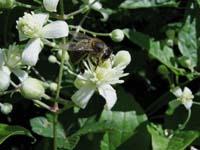Looking for the best queen

Not all beekeepers want to improve the same aspect; some aim to increase honey production, others want to create more real jelly or that bees are more docile or resistant to diseases...
Xabier Larrinaga is a beekeeper, specialist in the cultivation of queens and member of the Association of Beekeepers of Bizkaia. According to him, the aforementioned characteristics are partially hereditary and are transmitted mainly through the queen.
However, they also influence the genetic characteristics of the erlamangos. Especially in the aggressiveness the influence of the erlamandos is perceived, since the offspring of the aggressive heralding are usually aggressive. However, Larrinaga does not especially seek submission, since he often believes that aggressive bees give more honey.
Whether with one purpose or another, it is appropriate for the beekeeper to control the reproduction of the queen. To reproduce without human intervention, the queen leaves the hive and makes a bridal flight. It crosses with the claims that surround and keeps your child in the spermateca. In fact, the eggs are not fertilized until the time of laying; from the fecundated eggs are born the female bees (female workers and young queen). Erlamandanos are produced from non-fecundated eggs.
Beekeepers use the mass selection to control with what counterweight is crossed. The essence of this technique is simple: during the bridal flight of the queen, hives are placed with good erlamando. In this way, there are many possibilities that the queen crosses with the corresponding erlamando and not with those of any other hive.
Turning the workers into the queen

In addition to mass selection, there is another technique to control fertilisation: artificial insemination. In this case the control is total, since the queen inculents to the semen of the erlamandos chosen by the beekeeper.
First you have to get the queens. For this purpose, beekeepers use the doolittle method. Gilbert M. It is called this because it is based on the work done by the beekeeper Doolittle. In a book written in 1888 (Scientific queen-rearing as practically; being a method by which the best of queen-bees are), Doolittle explained how cells should be to grow. They must have a dome shape.
Subsequently, the beekeepers discovered the birth of the queens by placing the larvae in the dome-shaped cells. Through it they get as many reigns as they want. Yes, the larvae should be placed at the right time in the cells, in particular, when they have elapsed for maximum two days in the larval phase, with adequate feeding and surveillance throughout the development.
Inside the hive, the eggs that must become queen grow in special cells and only feed on royal jelly. However, of most eggs, worker bees are born. These eggs grow in hexagonal cells and the larvae feed only with royal jelly until three days. Since then, unusual bees give them pollen and honey.
Hence the importance of the transfer on time. If the larvae have more than 24 hours, they do not become queen. But before that, yes. This is demonstrated by Larrinaga: "We put the siren to the bees as we want."

With great care
The queens that are wanted inseminar are kept in the urns. After five or six days from birth, they are taken and subjected to carbon dioxide for four or five minutes. With this, the laying of eggs is encouraged. Then they reintroduce themselves to the hive and the next day they inseminate.
For inseminar you must first remove semen from the erlamangos. Pressing on the chest, the sexual organs are expelled, while the semen leaves and the beekeeper absorbs it with a syringe. In the semen extraction operation, the erlamando dies, but the same happens to him in nature when he crosses with the queen.
Eight microliters of semen per queen are needed, a quantity that is obtained by joining the semen of eight or ten erlamandarras. The semen is collected in a capillary tube of 12 millimeters and to avoid drying the physiological serum is also placed, but without touching the semen, since otherwise the sperm die.
Then the queen bee is extracted and allowed to fly to defend it. The beekeeper Xabier Larrinaga explains why: "It must be taken into account that it has remained in a closed place for six days and has not been able to make depositions. That is why it is allowed to fly so that it is clean at the inseminar".

Once cleaned, the queen is inserted into a tube and subjected again to the action of carbon dioxide, with the aim of this time being associated. He is willing to be then inseminated.
The beekeeper uses a lens that enlarges the image thirty times, using a pair of tongs, to open the back of the queen and see the entrance of the obidado. There he introduces the syringe. According to Larrinaga, you have to inject the semen carefully, since otherwise it leaves the vagina. To avoid this, semen should be introduced after a valve in the obiduct, from where it reaches the spermateca.
Once the insemination has been carried out, the queen removes carbon dioxide and is expected to recover. Then she returns to the beehive, and a few months later she begins to lay eggs, like any other queen. For example, you can lay 1,500 eggs a day during the first year and 2,000 in the second year. The bees born from these eggs will not be of any kind, since they are children of well-chosen parents.







